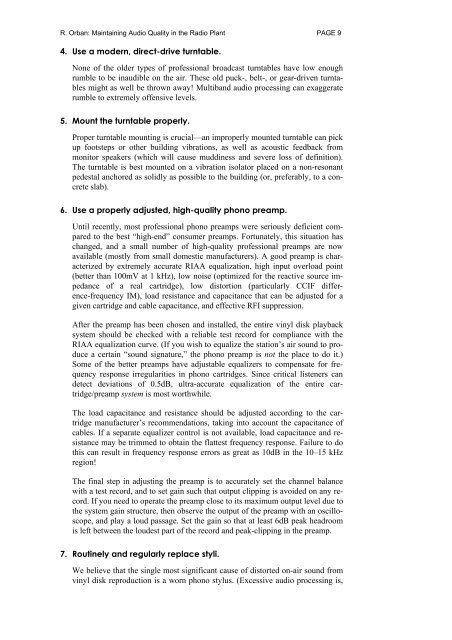Maintaining Audio Quality in the FM Plant - Orban
Maintaining Audio Quality in the FM Plant - Orban
Maintaining Audio Quality in the FM Plant - Orban
Create successful ePaper yourself
Turn your PDF publications into a flip-book with our unique Google optimized e-Paper software.
R. <strong>Orban</strong>: <strong>Ma<strong>in</strong>ta<strong>in</strong><strong>in</strong>g</strong> <strong>Audio</strong> <strong>Quality</strong> <strong>in</strong> <strong>the</strong> Radio <strong>Plant</strong> PAGE 9<br />
4. Use a modern, direct-drive turntable.<br />
None of <strong>the</strong> older types of professional broadcast turntables have low enough<br />
rumble to be <strong>in</strong>audible on <strong>the</strong> air. These old puck-, belt-, or gear-driven turntables<br />
might as well be thrown away! Multiband audio process<strong>in</strong>g can exaggerate<br />
rumble to extremely offensive levels.<br />
5. Mount <strong>the</strong> turntable properly.<br />
Proper turntable mount<strong>in</strong>g is crucial—an improperly mounted turntable can pick<br />
up footsteps or o<strong>the</strong>r build<strong>in</strong>g vibrations, as well as acoustic feedback from<br />
monitor speakers (which will cause mudd<strong>in</strong>ess and severe loss of def<strong>in</strong>ition).<br />
The turntable is best mounted on a vibration isolator placed on a non-resonant<br />
pedestal anchored as solidly as possible to <strong>the</strong> build<strong>in</strong>g (or, preferably, to a concrete<br />
slab).<br />
6. Use a properly adjusted, high-quality phono preamp.<br />
Until recently, most professional phono preamps were seriously deficient compared<br />
to <strong>the</strong> best “high-end” consumer preamps. Fortunately, this situation has<br />
changed, and a small number of high-quality professional preamps are now<br />
available (mostly from small domestic manufacturers). A good preamp is characterized<br />
by extremely accurate RIAA equalization, high <strong>in</strong>put overload po<strong>in</strong>t<br />
(better than 100mV at 1 kHz), low noise (optimized for <strong>the</strong> reactive source impedance<br />
of a real cartridge), low distortion (particularly CCIF difference-frequency<br />
IM), load resistance and capacitance that can be adjusted for a<br />
given cartridge and cable capacitance, and effective RFI suppression.<br />
After <strong>the</strong> preamp has been chosen and <strong>in</strong>stalled, <strong>the</strong> entire v<strong>in</strong>yl disk playback<br />
system should be checked with a reliable test record for compliance with <strong>the</strong><br />
RIAA equalization curve. (If you wish to equalize <strong>the</strong> station’s air sound to produce<br />
a certa<strong>in</strong> “sound signature,” <strong>the</strong> phono preamp is not <strong>the</strong> place to do it.)<br />
Some of <strong>the</strong> better preamps have adjustable equalizers to compensate for frequency<br />
response irregularities <strong>in</strong> phono cartridges. S<strong>in</strong>ce critical listeners can<br />
detect deviations of 0.5dB, ultra-accurate equalization of <strong>the</strong> entire cartridge/preamp<br />
system is most worthwhile.<br />
The load capacitance and resistance should be adjusted accord<strong>in</strong>g to <strong>the</strong> cartridge<br />
manufacturer’s recommendations, tak<strong>in</strong>g <strong>in</strong>to account <strong>the</strong> capacitance of<br />
cables. If a separate equalizer control is not available, load capacitance and resistance<br />
may be trimmed to obta<strong>in</strong> <strong>the</strong> flattest frequency response. Failure to do<br />
this can result <strong>in</strong> frequency response errors as great as 10dB <strong>in</strong> <strong>the</strong> 10–15 kHz<br />
region!<br />
The f<strong>in</strong>al step <strong>in</strong> adjust<strong>in</strong>g <strong>the</strong> preamp is to accurately set <strong>the</strong> channel balance<br />
with a test record, and to set ga<strong>in</strong> such that output clipp<strong>in</strong>g is avoided on any record.<br />
If you need to operate <strong>the</strong> preamp close to its maximum output level due to<br />
<strong>the</strong> system ga<strong>in</strong> structure, <strong>the</strong>n observe <strong>the</strong> output of <strong>the</strong> preamp with an oscilloscope,<br />
and play a loud passage. Set <strong>the</strong> ga<strong>in</strong> so that at least 6dB peak headroom<br />
is left between <strong>the</strong> loudest part of <strong>the</strong> record and peak-clipp<strong>in</strong>g <strong>in</strong> <strong>the</strong> preamp.<br />
7. Rout<strong>in</strong>ely and regularly replace styli.<br />
We believe that <strong>the</strong> s<strong>in</strong>gle most significant cause of distorted on-air sound from<br />
v<strong>in</strong>yl disk reproduction is a worn phono stylus. (Excessive audio process<strong>in</strong>g is,



![[PDF] Using the ITU BS.1770-2 and CBS Loudness Meters ... - Orban](https://img.yumpu.com/50629372/1/190x245/pdf-using-the-itu-bs1770-2-and-cbs-loudness-meters-orban.jpg?quality=85)






![[PDF] Optimod-FM Feature Comparison - Orban](https://img.yumpu.com/41741615/1/190x245/pdf-optimod-fm-feature-comparison-orban.jpg?quality=85)






